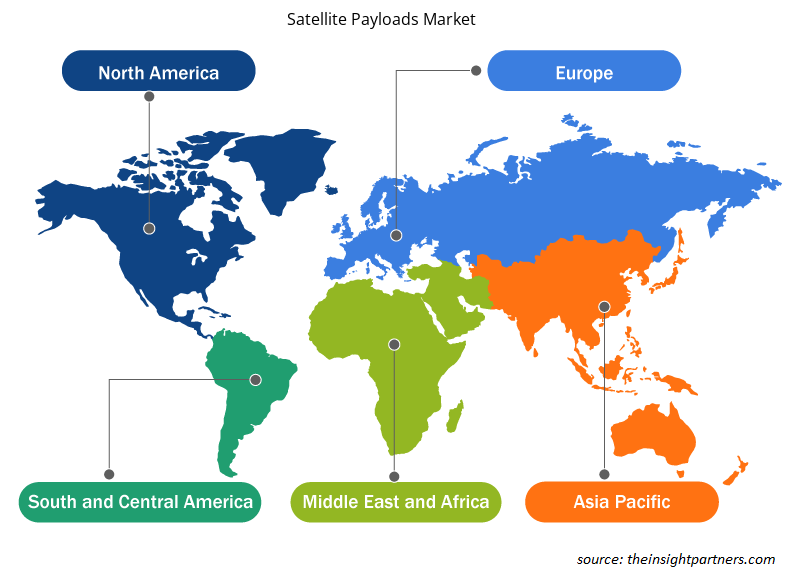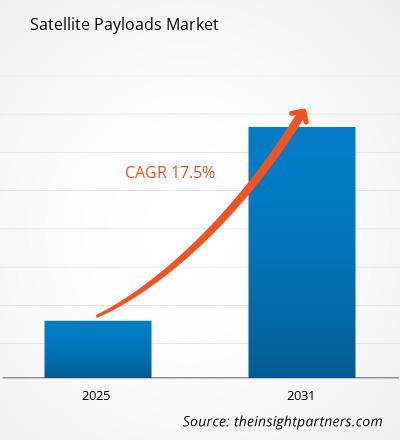من المتوقع أن يسجل سوق الحمولات الفضائية معدل نمو سنوي مركب بنسبة 17.5٪ من عام 2023 إلى عام 2031، مع توسع حجم السوق من XX مليون دولار أمريكي في عام 2023 إلى XX مليون دولار أمريكي بحلول عام 2031.
تم تقسيم التقرير حسب نوع المدار (المدار الأرضي المنخفض (LEO)، والمدار الأرضي المتوسط (MEO)، والمدار الجغرافي الثابت (GEO))، ونوع الحمولة (حمولة الاتصالات، وحمولة التصوير، وحمولة الملاحة، وغيرها)، والتطبيق (الاتصالات، والاستشعار عن بعد، والبحث العلمي، والمراقبة، والملاحة). كما تم تقسيم التحليل العالمي على المستوى الإقليمي والدول الرئيسية. ويقدم التقرير القيمة بالدولار الأمريكي للتحليل والقطاعات المذكورة أعلاه.
غرض التقرير
يهدف تقرير سوق الحمولات الفضائية الصادر عن The Insight Partners إلى وصف المشهد الحالي والنمو المستقبلي وأهم العوامل الدافعة والتحديات والفرص. وسيوفر هذا رؤى لمختلف أصحاب المصلحة في الأعمال التجارية، مثل:
- مزودي/مصنعي التكنولوجيا: لفهم ديناميكيات السوق المتطورة ومعرفة فرص النمو المحتملة، وتمكينهم من اتخاذ قرارات استراتيجية مستنيرة.
- المستثمرون: إجراء تحليل شامل للاتجاهات فيما يتعلق بمعدل نمو السوق، وتوقعات السوق المالية، والفرص المتاحة عبر سلسلة القيمة.
- الهيئات التنظيمية: لتنظيم السياسات ومراقبة الأنشطة في السوق بهدف تقليل الانتهاكات والحفاظ على ثقة المستثمرين والحفاظ على سلامة السوق واستقرارها.
تجزئة سوق الحمولات الفضائية
نوع المدار
- مدار أرضي منخفض
- مدار أرضي متوسط
- مدار ثابت جغرافيا
نوع الحمولة
- حمولة الاتصالات
- حمولة التصوير
- حمولة الملاحة
- آحرون
طلب
- اتصالات
- الاستشعار عن بعد
- البحث العلمي
- مراقبة
- ملاحة
الجغرافيا
- أمريكا الشمالية
- أوروبا
- آسيا والمحيط الهادئ
- أمريكا الجنوبية والوسطى
- الشرق الأوسط وأفريقيا
الجغرافيا
- أمريكا الشمالية
- أوروبا
- آسيا والمحيط الهادئ
- أمريكا الجنوبية والوسطى
- الشرق الأوسط وأفريقيا
قم بتخصيص هذا التقرير ليناسب متطلباتك
ستحصل على تخصيص لأي تقرير - مجانًا - بما في ذلك أجزاء من هذا التقرير، أو تحليل على مستوى الدولة، وحزمة بيانات Excel، بالإضافة إلى الاستفادة من العروض والخصومات الرائعة للشركات الناشئة والجامعات
- احصل على أهم اتجاهات السوق الرئيسية لهذا التقرير.ستتضمن هذه العينة المجانية تحليلاً للبيانات، بدءًا من اتجاهات السوق وحتى التقديرات والتوقعات.
محركات نمو سوق الحمولات الفضائية
- زيادة الطلب على خدمات الاتصالات: الطلب المتزايد على خدمات النطاق العريض والاتصالات المتنقلة بسبب زيادة استخدام الإنترنت وزيادة مستخدمي الهواتف المحمولة مما يدفع إلى الحاجة إلى حمولات أقمار صناعية متقدمة يمكنها توفير اتصال عالي الإنتاجية.
- الإنفاق الحكومي على برامج الفضاء: إن الاستثمار الحكومي المتزايد والتركيز المتزايد على برامج استكشاف الفضاء يعززان نمو سوق الحمولات الفضائية.
الاتجاهات المستقبلية لسوق الحمولات الفضائية
- التوسع في الأسواق الناشئة: هناك فرصة هائلة للنمو في الاقتصادات الناشئة حيث يركز العالم أجمع على أنشطة استكشاف الفضاء. ومع تقدم برامج الفضاء في مختلف البلدان، من المتوقع أن يرتفع الطلب على مثل هذه الحمولات الفضائية.
- العدد المتزايد من الشركات: إن العدد المتزايد من الشركات التي تصنع تقنيات الفضاء والأقمار الصناعية في جميع أنحاء العالم يعمل أيضًا على تعزيز المنافسة الشديدة والتي من المتوقع أيضًا أن تدفع نمو السوق خلال الفترة المتوقعة.
فرص سوق الحمولات الفضائية
- العدد المتزايد من الأقمار الصناعية الصغيرة: إن العدد المتزايد من الأقمار الصناعية الصغيرة لمختلف أنشطة استكشاف الفضاء يعزز نمو سوق الحمولات الفضائية.
- التطورات في تكنولوجيا الاستشعار: إن التطوير المستمر في تكنولوجيات الاستشعار، مثل أجهزة الاستشعار المصغرة وقدرات التصوير المتقدمة، يمكن أن يفتح فرصًا أمام مصنعي الحمولات لتصميم حمولات تعمل على تعزيز جمع البيانات وتحليلها لتطبيقات محددة.
رؤى إقليمية حول سوق الحمولات الفضائية
لقد قام المحللون في Insight Partners بشرح الاتجاهات والعوامل الإقليمية المؤثرة على سوق الحمولات الفضائية طوال فترة التوقعات بشكل شامل. يناقش هذا القسم أيضًا قطاعات سوق الحمولات الفضائية والجغرافيا في جميع أنحاء أمريكا الشمالية وأوروبا ومنطقة آسيا والمحيط الهادئ والشرق الأوسط وأفريقيا وأمريكا الجنوبية والوسطى.

- احصل على البيانات الإقليمية المحددة لسوق حمولات الأقمار الصناعية
نطاق تقرير سوق الحمولات الفضائية
| سمة التقرير | تفاصيل |
|---|---|
| حجم السوق في عام 2023 | XX مليون دولار أمريكي |
| حجم السوق بحلول عام 2031 | XX مليون دولار أمريكي |
| معدل النمو السنوي المركب العالمي (2023 - 2031) | 17.5% |
| البيانات التاريخية | 2021-2022 |
| فترة التنبؤ | 2024-2031 |
| القطاعات المغطاة | حسب نوع المدار
|
| المناطق والدول المغطاة | أمريكا الشمالية
|
| قادة السوق وملفات تعريف الشركات الرئيسية |
|
كثافة اللاعبين في سوق الحمولات الفضائية: فهم تأثيرها على ديناميكيات الأعمال
يشهد سوق حمولات الأقمار الصناعية نموًا سريعًا، مدفوعًا بالطلب المتزايد من المستخدم النهائي بسبب عوامل مثل تفضيلات المستهلكين المتطورة والتقدم التكنولوجي والوعي المتزايد بفوائد المنتج. ومع ارتفاع الطلب، تعمل الشركات على توسيع عروضها والابتكار لتلبية احتياجات المستهلكين والاستفادة من الاتجاهات الناشئة، مما يؤدي إلى زيادة نمو السوق.
تشير كثافة اللاعبين في السوق إلى توزيع الشركات أو المؤسسات العاملة في سوق أو صناعة معينة. وهي تشير إلى عدد المنافسين (اللاعبين في السوق) الموجودين في مساحة سوق معينة نسبة إلى حجمها أو قيمتها السوقية الإجمالية.
الشركات الرئيسية العاملة في سوق الحمولات الفضائية هي:
- إيرباص ساس
- شركة بوينج
- شركة هاريس
- شركة هونيويل الدولية
- شركة انتلسات
إخلاء المسؤولية : الشركات المذكورة أعلاه ليست مرتبة بأي ترتيب معين.

- احصل على نظرة عامة على أهم اللاعبين الرئيسيين في سوق الحمولات الفضائية
نقاط البيع الرئيسية
- التغطية الشاملة: يغطي التقرير بشكل شامل تحليل المنتجات والخدمات والأنواع والمستخدمين النهائيين لسوق الحمولات الفضائية، مما يوفر صورة شاملة.
- تحليل الخبراء: تم تجميع التقرير على أساس الفهم العميق لخبراء الصناعة والمحللين.
- معلومات محدثة: يضمن التقرير أهمية الأعمال التجارية بسبب تغطيته للمعلومات الحديثة واتجاهات البيانات.
- خيارات التخصيص: يمكن تخصيص هذا التقرير لتلبية متطلبات العملاء المحددة وبما يتناسب مع استراتيجيات العمل بشكل مناسب.
وبالتالي، يمكن أن يساعد تقرير البحث حول سوق الحمولات الفضائية في تمهيد الطريق لفك شفرة وفهم سيناريو الصناعة وآفاق النمو. ورغم وجود بعض المخاوف المشروعة، فإن الفوائد الإجمالية لهذا التقرير تميل إلى التفوق على العيوب.
- التحليل التاريخي (سنتان)، سنة الأساس، التوقعات (7 سنوات) مع معدل النمو السنوي المركب
- تحليل PEST و SWOT
- حجم السوق والقيمة / الحجم - عالمي، إقليمي، بلد
- الصناعة والمنافسة
- مجموعة بيانات إكسل
التقارير الحديثة
شهادات العملاء
سبب الشراء
- اتخاذ قرارات مدروسة
- فهم ديناميكيات السوق
- تحليل المنافسة
- رؤى العملاء
- توقعات السوق
- تخفيف المخاطر
- التخطيط الاستراتيجي
- مبررات الاستثمار
- تحديد الأسواق الناشئة
- تحسين استراتيجيات التسويق
- تعزيز الكفاءة التشغيلية
- مواكبة التوجهات التنظيمية





















 احصل على عينة مجانية ل - سوق حمولات الأقمار الصناعية
احصل على عينة مجانية ل - سوق حمولات الأقمار الصناعية